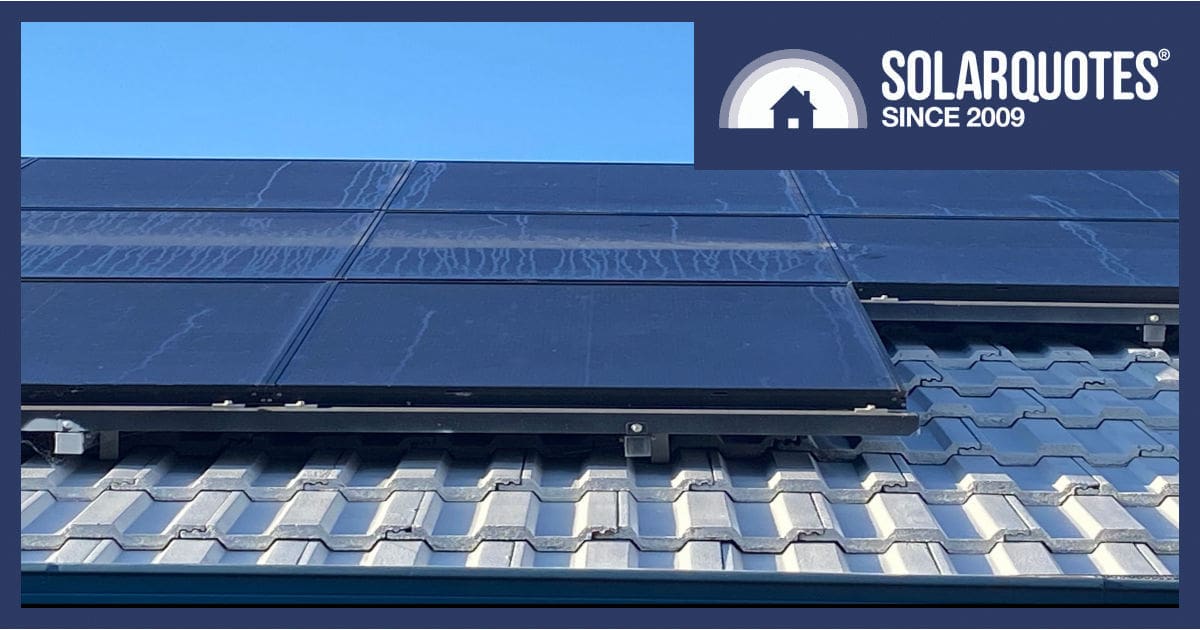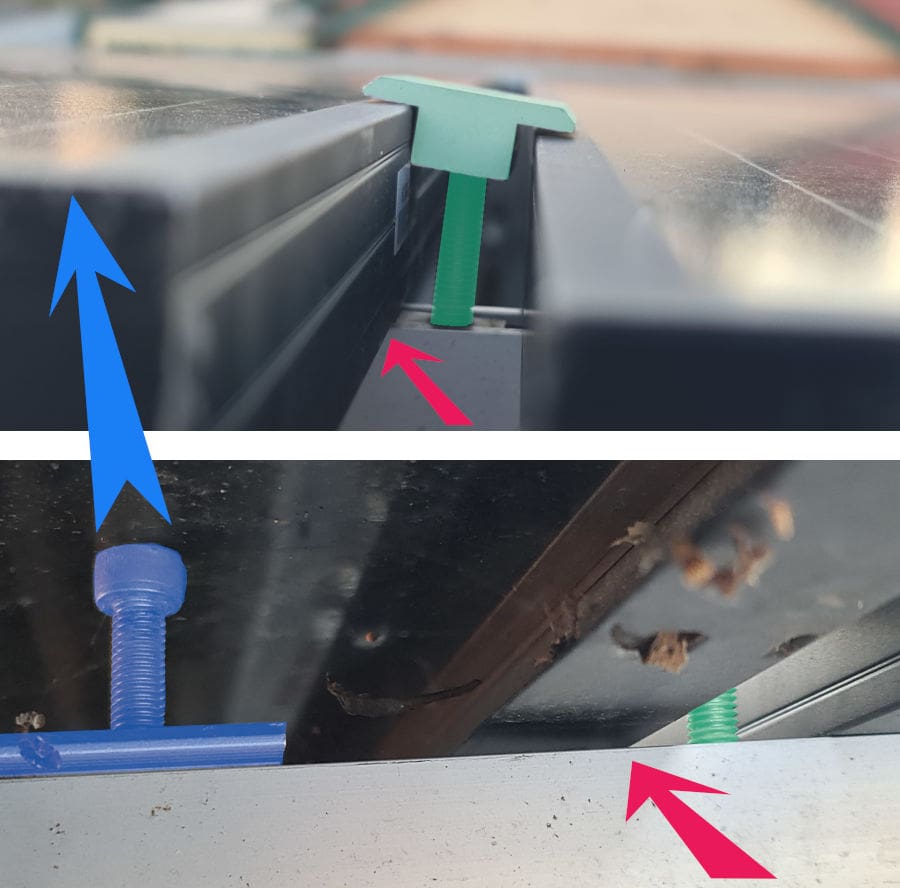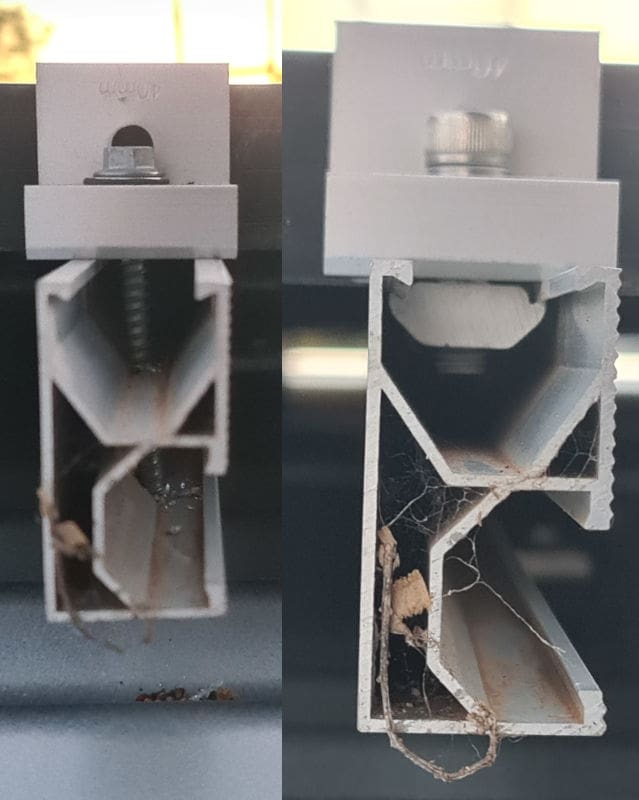
Image: Facebook
I’ve seen more than one instance where roof restorers have ruined solar arrays, and it’s a horribly wasteful lesson for people to learn. If you’re thinking of having your roof painted, then make sure it doesn’t go pear-shaped with this simple guide to restoring a roof with solar panels on it.
Roof paint is obviously designed to stick to things, and solar panels are no exception. You might think that because they’re made from glass, they’re easy to clean, but you’d be wrong. Unlike your windows, solar panels have a textured finish, so they don’t reflect light. That’s right, folks—solar panels are designed to absorb sunlight. Who knew?
Some manufacturers claim special anti-glare, anti-reflective, and anti-soiling properties for their proprietary coatings or surface treatments. The bottom line is: you can’t clean this surface using harsh chemicals or mechanical means without damaging it.
Using a pressure washer is also a No-No because it can inject water under the frame and into the edge of the panels. Once the seal is compromised and the wafers or busbars start to corrode, earth leakage faults will be fatal to the panels.
Paint on panels is a really simple problem to solve though.
Either you completely cover the array with drop sheets. Or you remove most of the solar power system before painting.
There are pros and cons to both methods, so we’ll outline a few of them here.[/caption]
Mask Up And Use Cover
Sealing your system off with plastic drop sheets isn’t terribly difficult. It’s fast and cheap and doesn’t require any particular licencing or indeed, much skill. This should be the minimum level of service you get from anybody who is painting a roof.
I have seen some painting jobs that look really nice because the framing is colour-coded to match the roof. However, there are a few potential traps.
Rooftop isolators
If your solar was installed before 2016, it likely has a rooftop isolator without a metal shade. Some even had a transparent door over the switch mechanism. These plastic housings would really benefit from a heavy coat of protective acrylic membrane. However, it’s not best practice to seal the door shut with paint or obliterate the labels identifying the isolator.
If we’re being honest, rooftop isolators might last longer if they’re painted, but the best approach has always been to remove these fire-prone switches before they cause a real calamity.
Incomplete Coverage
As the cover image shows, the person who performed this paint job didn’t know what they were doing.
Firstly, they haven’t properly secured the drop sheets, so some parts of the framing have copped a coat of paint, and others haven’t. While it might have looked all right at the outset, paint can easily be blown into small gaps if the system isn’t properly masked off.
Secondly, and most tragically, they skimped out on plastic when they covered the array. The bottom panels have obviously been protected, but where the plastic ends, the paint begins in a ghostly image of incompetence.
Landlords Special
You might have seen a house with only the very front face of the roof painted, which looks flashy in real estate ads. Some solar installations appear similarly half-arsed when a new system is installed that doesn’t cover the footprint of the old one, and some unpainted roofs are left exposed next to a new array.
Remove, Restore, Refit.
Assuming your system is good quality, well installed and not terribly old, it’s perfectly good to remove the system temporarily while the roof is being attended to. Removal is usually fairly straightforward but reinstallation, testing and certification must certainly be done by a qualified electrician. As a qualified builder and roof plumber, I can offer one golden rule:
Do not allow roofing contractors to reinstall your solar, no matter what they tell you.
I’ve seen more than a few examples of dangerous work performed by roofers who don’t know what they’re doing.

Why is the green clamp crooked? The panel isn’t clamped down on the frame where the red arrow is… because the blue clamp shouldn’t even be under the panel. I’m amazed this bolt head didn’t break the glass but the roofers certainly damaged the panel.
Aim For The Best,
The best roof restorations are carried out without any solar. In fact, I’ll argue that the best solar arrays are started with restoration in mind.
Given free rein to go close to the edges, the installers can make best use of the roof space with least structural or panel clamp zone compromises. Once the brackets are installed, the tiles ground and the electrical penetration is made; then you can get the roof restorers to repoint the hips and ridges and paint as they see fit. Make sure they do some spare tiles too.
Prepare For The Worst
If your solar power system is older, removal can spell its doom.
Stainless steel and aluminium fixings can corrode together so tightly, they might as well be welded, especially if you’re close to the coast. Obsolete brands can mean new hardware is unobtainable so the whole frame is written off.

Points for innovation. When the iron roofers lost some of the parts, they’ve had to improvise with wood screws.
Plugs and wiring can be damaged, so they may also need renewing. Cracks in the plastic backing sheet on the modules aren’t always obvious from the front side; however, they might render the panels unsafe to reinstall.
As we’ve detailed before, the labour to reinstall old solar is much the same as installing new.
By the time you consider system size, improved performance, removal of isolators, better monitoring and fresh warranty, new solar can be a no brainer.
Be Alert To The Risk
Old solar arrays may be best served by simply covering them up properly before painting and letting them be.
While price is often an indicator, the unfortunate customer in our cover image didn’t employ the cheapest numpty they could find.
One of the best ways to ensure your system is safe is to ask your prospective roof restoration contractor for their insurance details. If they can’t provide proof of professional insurance, they’re obviously not a professional outfit.

 RSS - Posts
RSS - Posts



I’ve seen installations where the roof is clearly terminal, rusted and coming loose in various places. Do installers ever say to a household, um, I think maybe you should get the roof fixed before we put these panels up? I know that may potentially cost them work, but they must see the quality of some of these roofs and wince.
This is a very interesting comment… ….but the best approach has always been to remove these fire-prone switches before they cause a real calamity.
Perhaps an article detailing what’s required for a compliant retorfit if property owners choose to follow your advice and are removing rooftop isolators…
Nobody should be restoring a roof with Solar unless they were a very early adopter of the solar installation has damaged it.
Roof rework should have been performed when the solar was installed, and it should be good for 50 or 60 odd years. That mean 2 other solar installs.
Do not skimp on the roof to save a dollar now if it will cost you later.
“Stainless steel and aluminium fixings can corrode together so tightly, they might as well be welded”
I’ve always wondered why the stainless screw and aluminium nuts? Why not make the nut out of stainless as well, then this issue would not come up so bad!
It’s not the nuts that are aluminium, it’s the rails and roof mounts. I assume they don’t use aluminium nuts and bolts because they are too soft or too expensive. Or both.
The internally threaded “nub” is aluminium. That is the chunk that tightens against the shaped socket section of the rail. Diesel fuel can help dissolve the resultant corrosion which often occurs when dissimilar metals come into contact and the resultant electrolysis is helped along by dirty moisture laden atmosphere. I spray lanolin based lubricant onto all threads which are to be installed outdoors.
Yes it is the nuts that are aluminium on the most common rack.
Hi Jacob, Aluminium and stainless steel don’t get along well especially in a coastal situation. I have used a product made in Qld made called Tef- gel. This product is very to prevent corrosion and galling.
Hi Ian,
Anti seize compound is a real winner on stainless and alloy threads. I use Neverseize, but hardly anyone else does sadly.
Thanks Anthony.
Yes it’s a looming problem for many, but there are alternative technology choices emerging now that not only avoid this issue, but take advantage of it, to replace old solar PV systems, from the inefficient, costly, and old school flat panel PV systems; with a modern era energy dense Gen-4 Solar PV Technology.
Not familiar with the term Stage-4 Solar?
I have had an involvement since 2010 with this form of technology in various forms of proof of concept at an R&D level in China with some Chinese company colleagues and authored and delivered a paper introducing this concept [PV Energy Cube] to 120 mainly German Researchers, Academics and Engineers, at a Solar Praxis Conference in Berlin in Jan 2013.
I organised a tour for 16 Australian Solar PV Installers/Contractors to come to China in 2010 and spent 14 days introducing them to many of the heavy hitters in the Chinese Renewable Energy Industry at the time involved with Solar PV, Wind, and Hydro, Technologies. The Australian Ambassador to China was part of the group also. These installers and contractors went on to develop direct supply line contracts with manufacturers as a result of that initial tour.
I recall introducing the Stage-4 Solar PV design concepts [volume based rather than area based PV technology] to the group on day one of the tour, and it raised some eyebrows.
I also advised Ron Brakels and Finn about this about subject over 9 years ago now.
https://reneweconomy.com.au/what-comes-after-solar-pv-bipv-88351/
Keep an eye out for it soon.
Lawrence Coomber
I’m planning a new solar install this summer and had already decided to have the roof painted before the panels went on. Can anyone recommend a good roof painter / restorer in Melbourne? The roof is colourbond steel, 30 years old.
Is restoring an old(40+ years) tiled roof even worth it? Seems to be conflicting info….doesn’t seem to last long?
I’ve just bought an older house….built in 83′, concrete roof tiles that look to be in ok condition(haven’t actually gotten up there yet)….very faded….builder said glazing/or whatever coating was on them is gone….would love a new colorbond roof….would love solar, but cant afford both….so it’s a roof restoration(if it even needs one) and solar OR new colorbond.
Hi, re the ’83 concrete tiled roof.
The colouring on the concrete roof continually leeches off. It’s getting in your gutters and wherever runoff ends up.
In addition the solar panel supporting system, where it attaches to the roof traps roof run-off including fine paint particles, debris, tree litter and dust.
I have just high pressure cleaned my roof with a 4000 PSI machine from Kennards.
Pointed the hips and painted the roof.
Painted with Nutech white which offers a claimed 92% light reflection.
I can confirm the roof surface has dropped dramatically to touch after painting.
Having painted the roof except underneath the existing panels, I signed up for a new solar system 6.6kw and 5kw Redx battery for $6.5k after rebate. ($2.2k rebate) Plus $400 to remove existing 3.3kw solar system including Sunny Boy inverter. Bit sad to see it go.
After removal of the old system i cleaned, sealed and painted the area. Waiting now for Solar Xcellence to instaĺ new system.
Solar rebate will drop from 7.1 cents per kw/hour to 2 cents, except 10 cents per kw hour 3pm to 9pm here in the West.
But looking forward to the cooling effect of my beautiful white roof against the red hot summer.
Pressure cleaning old concrete roof tiles is inadvisable unless you are experienced . Too much pressure on brittle tiles severely weakens them . They are already quite porous once colouring gone . They generally have a life expectancy of 40 -50 years max . Pressure cleaning them may well shorten their life span
Our home is approx 50 years old and had a concrete tile roof which was getting brittle. When Our solar installer was quoting he inspected the roof and said some tiles could break during installation. We decided to replace the roof with colour bond and also had the Ducted aircon unit replaced before the new roof went on. Yes it was a costly exercise But we now have a Roof, A/C and Solar system which will last & I don’t need to worry about.
If we all of us had a crystal ball life would be so great. In saying that maybe we should adopt a flow chart method of installation . I’m guilty of the same mistakes.